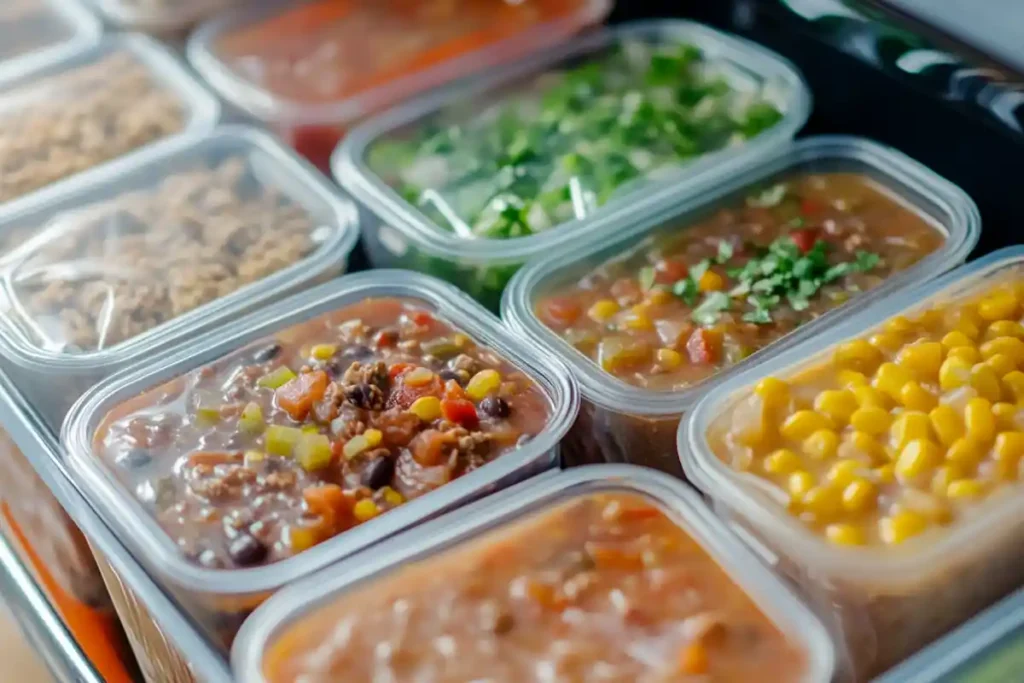Taco soup is a crowd-pleaser, loaded with bold flavors, hearty ingredients, and a touch of spice. But what happens when you’ve made more than your family can handle in one sitting? Fear not—freezing taco soup is a fantastic way to preserve it for another day. In this article, we’ll explore everything you need to know about freezing taco soup, from the best storage practices to how long it stays fresh in the freezer. Along the way, we’ll dish out tips on reheating, avoiding common mistakes, and even compare how taco soup stacks up to other soups in terms of freezer longevity. Let’s dive in!
1. Understanding Freezing and Storage for Taco Soup
What Makes Taco Soup a Freezer-Friendly Meal?
Taco soup isn’t just tasty—it’s practical. Its combination of broth, beans, tomatoes, and spices creates a dish that holds up well under freezing. Unlike cream-based soups that may separate or lose texture when frozen, taco soup maintains its consistency. The ingredients are sturdy and freeze beautifully, making this dish a go-to choice for meal prep enthusiasts.
Soups with a tomato base, like taco soup, have a natural advantage. The acidity in tomatoes helps retain flavor over time, ensuring your soup tastes just as delicious weeks later. Additionally, the mix of proteins like ground beef or chicken, along with hearty vegetables like corn and peppers, makes this soup a nutritional powerhouse that’s ready to reheat when you’re short on time.
The Science of Freezing Soups Like Taco Soup
Freezing is more than just a convenient storage method—it’s a science. When taco soup is frozen, the water content in the broth and vegetables forms ice crystals. While freezing preserves the soup’s nutritional value and flavors, those ice crystals can sometimes affect texture, especially if the soup isn’t stored correctly.
By understanding how freezing works, you can take steps to preserve the freshness and flavor of your taco soup. For example, ensuring the soup cools completely before freezing can prevent excessive ice formation. This step also minimizes the risk of freezer burn, which occurs when air reaches the food and causes dehydration.
In addition to proper cooling, using airtight containers or freezer bags is crucial. These materials help block out air and moisture, keeping the taco soup’s quality intact. Trust us—you’ll appreciate the effort when you taste your reheated soup weeks later.
2. Best Practices for Freezing Taco Soup
How to Properly Store Taco Soup in the Freezer

Freezing taco soup might seem straightforward, but doing it correctly ensures it tastes just as delicious when reheated. Start by allowing the soup to cool completely. Putting hot soup directly into the freezer can raise the freezer’s temperature, affecting the quality of other frozen items.
Once cooled, transfer the soup to airtight containers or heavy-duty freezer bags. Using freezer-safe containers minimizes the risk of freezer burn, which can ruin the flavor and texture. If you’re using bags, lay them flat in the freezer to save space. Be sure to leave about an inch of space at the top of the container or bag to allow for expansion as the soup freezes.
Label your containers with the date and contents. This small step prevents confusion and ensures you know exactly how long the soup has been frozen. Generally, taco soup remains in peak condition for about 4–6 months in the freezer.
For an in-depth guide on freezing other recipes like taco soup, check out Smart Recipes’ Taco Soup Frios Recipe.
Common Mistakes to Avoid When Freezing Taco Soup
While freezing soup is easy, certain mistakes can jeopardize its quality. One common error is overfilling containers. As soup freezes, it expands, which can cause lids to pop off or bags to burst. To avoid this, leave that extra inch of space at the top.
Another mistake is using containers that aren’t freezer-safe. Thin plastic containers or bags may crack or allow air to seep in, leading to freezer burn. Always choose high-quality, thick freezer bags or containers.
Finally, don’t forget to portion out your soup before freezing. If you freeze a large batch in one container, reheating only a portion becomes tricky. Instead, freeze taco soup in individual servings to make mealtime more convenient.
3. How Long Taco Soup Can Last in the Freezer?
General Guidelines for Freezing Taco Soup
So, how long will taco soup last in the freezer? Typically, taco soup stays fresh for up to 4–6 months when stored properly. Beyond this timeframe, it’s still safe to eat but may lose its vibrant flavors and textures. The key is to store it in airtight containers or bags to prevent freezer burn and to maintain a consistent freezer temperature of 0°F (-18°C) or lower.
If your soup contains ingredients like dairy (e.g., sour cream or cheese), it’s best to freeze the base soup separately and add these toppings fresh when reheating. Freezing dairy can alter the texture, making it grainy or separated.
Signs Your Taco Soup May Have Spoiled in the Freezer
Even though freezing significantly extends taco soup’s shelf life, it’s not foolproof. Look out for these warning signs that your soup may have gone bad:
- Freezer Burn: White, icy crystals or dry patches on the surface of the soup indicate freezer burn. While it’s not harmful, it can make the soup taste stale.
- Off Smell: If the soup smells sour or off when thawed, it’s best to discard it.
- Texture Changes: If the soup separates or has an unappetizing appearance, it may not be worth salvaging.
By following these storage tips and knowing when to toss it, you can enjoy your taco soup at its flavorful best.
4. Reheating and Serving Taco Soup After Freezing
How to Safely Reheat Frozen Taco Soup

Reheating taco soup properly is essential to preserve its flavor and texture. Start by defrosting the soup in the refrigerator overnight. Slow thawing helps maintain its consistency and prevents any unexpected texture changes. If you’re in a rush, place the frozen container in a bowl of cold water for faster thawing.
Once thawed, you can reheat taco soup on the stovetop, in the microwave, or even in a slow cooker. For stovetop reheating, pour the soup into a pot and warm it over medium heat, stirring occasionally to prevent sticking. If using a microwave, reheat in a microwave-safe bowl, stirring at regular intervals to ensure even heating. For busy days, the slow cooker is a great option—set it on low heat and let the soup warm up gradually.
Remember, avoid boiling the soup as this can alter the flavor and cause delicate ingredients to break down.
Maintaining Flavor and Quality After Freezing
To keep your reheated taco soup tasting as fresh as the day you made it, add garnishes like shredded cheese, sour cream, or chopped cilantro just before serving. These toppings bring back the vibrant, fresh flavors that might have muted slightly during freezing.
If the soup feels a bit thick after reheating, add a splash of broth or water to adjust the consistency. For more inspiration on enhancing reheated dishes, check out Smart Recipes’ Taco Soup Frios Recipe.
5. Comparisons and Related Freezer-Friendly Soups
How Taco Soup Compares to Other Soups in Freezer Longevity
How long will taco soup last in the freezer? With proper storage, taco soup can maintain its flavor and quality for up to 4–6 months. When compared to other soups, its shelf life is quite impressive. Soups like vegetable or chicken noodle soup tend to last a similar amount of time, but creamy soups often fare worse. Dairy-based soups can separate or become grainy when frozen, making taco soup a better candidate for meal prep.
Additionally, the robust ingredients in taco soup, such as beans, corn, and tomatoes, hold up exceptionally well during freezing and reheating. This durability makes taco soup a versatile and reliable option for freezer storage.
Why Soups Like Tortilla Soup May Have Different Freezing Durations
Tortilla soup shares many similarities with taco soup but often contains toppings like tortilla strips or avocado that don’t freeze as well. For the best results, freeze only the base soup and add these delicate garnishes fresh after reheating. This approach ensures both soups remain flavorful and visually appealing.
For more ideas on freezer-friendly meals, explore recipes on Smart Recipes. You’ll find a range of hearty dishes to keep your freezer stocked and your meals stress-free.
6. Frequently Asked Questions (FAQs)
How Long Can You Keep Taco Soup in the Freezer?
How long will taco soup last in the freezer? Properly stored, taco soup can last up to 4–6 months in the freezer while maintaining its flavor and texture. Beyond this time, it may still be safe to eat but might lose its freshness. Using airtight containers and keeping the freezer temperature consistent are crucial for preserving quality.
How Long Can You Keep Homemade Soup in the Freezer?
Homemade soups, including taco soup, generally freeze well for 2–6 months, depending on the ingredients. Broth-based soups like taco soup last longer compared to cream-based varieties. Always ensure soups are cooled properly and stored in freezer-safe containers to prevent freezer burn.
How Long Is Taco Soup Good for Before Freezing?
If you’ve prepared taco soup but can’t eat it all right away, refrigerate it for up to 3–4 days before freezing. Freezing it sooner helps lock in the fresh flavors and prevents spoilage.
How Long Does Tortilla Soup Last in the Freezer?
Similar to taco soup, tortilla soup can last 4–6 months in the freezer. The broth and vegetables hold up well, but as with taco soup, it’s best to freeze without toppings like tortilla strips or cheese for optimal results.
7. Additional Tips for Freezing and Storing Soups
How to Label and Organize Soups in the Freezer
Proper labeling and organization make finding your taco soup in the freezer a breeze. Always label containers with the date and contents, such as “Taco Soup, Jan 2025.” This ensures you know how long taco soup has been in the freezer. Group soups together in one section of the freezer to save time and avoid accidental spoilage.
Extending the Shelf Life of Soups Through Proper Techniques
For even longer storage, consider vacuum-sealing your taco soup. Removing air prevents freezer burn and keeps the soup fresh for up to a year. Additionally, regularly check your freezer’s temperature to ensure it stays at 0°F (-18°C) or below. Keeping the freezer well-stocked also helps maintain a consistent temperature.
By following these tips, you can enjoy your taco soup and other soups without worrying about quality loss. Proper storage ensures you’ll always have a comforting, flavorful meal ready whenever you need it.
8. Comparing Taco Soup to Other Soups for Freezing
How Taco Soup Compares to Other Soups in Freezer Longevity
When it comes to freezing, taco soup holds up remarkably well. Its broth-based foundation, combined with hardy ingredients like beans, tomatoes, and corn, makes it ideal for long-term storage. How long will taco soup last in the freezer? Up to 4–6 months, which is comparable to similar soups like chili or vegetable stew.
In contrast, cream-based soups or those with pasta tend to lose their texture and flavor more quickly. For example, soups with dairy may separate when frozen, resulting in a grainy texture upon reheating. By comparison, taco soup maintains its robust flavor and hearty texture much better.
Why Soups Like Tortilla Soup May Have Different Freezing Durations
While taco soup and tortilla soup share many ingredients, tortilla soup often includes more delicate components like tortilla strips, avocado, or cheese. These ingredients can degrade in the freezer, so it’s best to add them fresh after reheating.
To extend the lifespan of any soup, ensure proper storage techniques, such as using airtight containers and freezing at a consistent temperature of 0°F (-18°C). This way, soups like taco soup remain flavorful and ready to enjoy whenever you need a quick meal.
9. Wrapping Up and Final Thoughts
Taco soup is not only a comforting and delicious meal but also one of the most freezer-friendly dishes you can prepare. How long will taco soup last in the freezer? With proper storage, it stays fresh for up to 6 months, making it a perfect option for meal prep or saving leftovers.
By following the tips in this guide—cooling the soup before freezing, using airtight containers, and avoiding common mistakes—you can ensure your soup retains its flavor and texture. Whether you’re planning ahead for busy nights or simply preserving extra servings, freezing taco soup is a practical and tasty solution.
Don’t forget to label your containers and store the soup in manageable portions for easy reheating. With the right techniques, you’ll always have a delicious bowl of taco soup ready to enjoy. Happy cooking and freezing!

